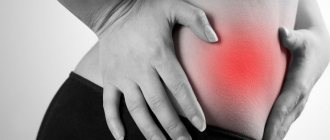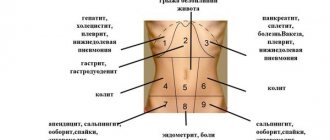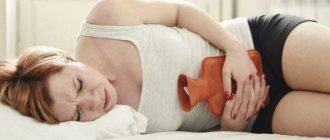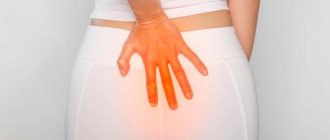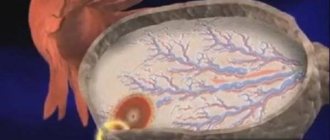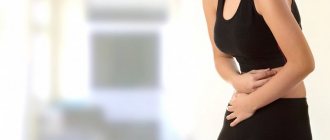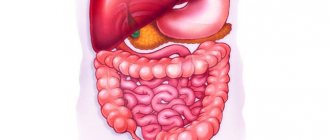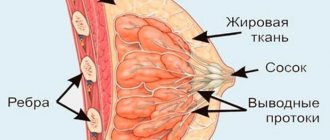Many women are accustomed to considering severe pain in the lower abdomen before menstruation as the norm. However, this is not the case. Physiologically normal is a painless course of the menstrual cycle, let's say slight discomfort, a feeling of fullness in the lower abdominal cavity immediately before or during the menstrual period. If your right side hurts before your next period, you should assume the development of a pathology. In this case, it is necessary to exclude the possibility of inflammatory diseases of the reproductive and digestive systems, surgical, and neurological diseases. The reasons why there is pain in the right side before the onset of menstruation may require urgent medical intervention.
Causes of pain in the side during ovulation
The process of follicle maturation and egg release in the middle of the cycle can be painful if the production of prostaglandins is disrupted. In this case, the sides hurt during ovulation and before menstruation. Excessive enlargement of follicles sometimes leads to the formation of so-called functional cysts, which, under the influence of hormones, resolve within 1–3 months. In this case, before menstruation, the side on the side where the tumor arose may hurt.
A woman’s physical well-being during and after ovulation is influenced by the state of her blood circulation. In the second half of the cycle, there is a tendency to retain fluid in the body, which leads to increased pressure on peripheral vessels in the tissues and the development of swelling. The causes of pain in this case may be:
- lack of physical activity;
- stagnation of blood in the abdominal organs;
- obesity;
- peculiarity of the location of the uterus and appendages.
The pain is nagging, mild or moderate in nature, and is regularly repeated during each cycle. Short-term spasmodic attacks are possible on the left or right side, caused by contractions of smooth muscles.
Why does my stomach hurt during menstruation?
Pain in the lower abdomen during menstruation of moderate intensity is physiological. Symptoms usually appear on the first day and disappear on their own within a short period of time. Pronounced pain is a pathology, so it is important to understand the cause of severe pain in the lower abdomen.
When does your stomach hurt?
Depending on the day of the menstrual cycle, there are several periods when algomenorrhea appears:
- The pain appears on the eve of menstruation, approximately 2-3 days before the onset of bleeding. This is the so-called premenstrual syndrome, which is typical for adolescents and girls under 18 years of age. The main reason for the appearance of such symptoms is a change in the production of sex hormones;
- Painful sensations come during the period of bleeding. This occurs due to the increased production of biologically active substances - prostaglandins. They cause quite painful contractions of the uterine muscles in the first two days of menstruation;
- Pain in the lower abdomen after menstruation appears due to the normalization of hormonal levels in women of reproductive age.
Causes of painful menstruation
Algodismenorrhea can be divided into several types:
- Primary, which appears with the onset of menarche and is usually not associated with pathology;
- Secondary is a consequence of many gynecological diseases;
- Organic manifests itself in the case of pathology of the reproductive system;
- Functional - the intensity of pain depends on the concentration of sex hormones responsible for the onset of menstruation.
Causes of painful periods in nulliparous women
Young girls experience pain during menstruation much more often than women of reproductive age. This happens due to the formation of hormonal levels. After the development of a regular menstrual cycle and normalization of hormone levels, the pain stops or becomes less intense.
Teenage girls also experience painful periods due to mood changes, emotional lability and the presence of unfavorable psycho-emotional states. Sometimes, under severe stress, menstruation may occur earlier.
Constitutional features also affect the occurrence of pain during menstruation. In excessively thin girls, the pain syndrome is more pronounced. Sometimes low body weight is a consequence of infantilism or underdevelopment of the reproductive system. Hypoplasia of the uterus and poor development of muscle elements, which are difficult to stretch during menstrual plethora, lead to irritation of nerve endings and the occurrence of pain.
Mechanism of pain
The feeling of painful symptoms and discomfort during menstruation is explained by contraction of the muscles of the uterus. When blood clots and fragments of exfoliated endometrium accumulate in the uterine cavity, there is a need to quickly empty the uterine cavity of them. The muscle fibers in the wall of the uterus begin to contract intensely, and its contents are evacuated. In this case, unpleasant pain in the lower abdomen may appear. The stronger the muscles contract, the higher the likelihood of pain.
There is a hypothesis that menstrual pain is a consequence of an increase in the level of prostaglandins in the endometrium and blood plasma. Prostaglandins are complex chemical compounds that have a pronounced biologically active effect. They stimulate and enhance the contractile function of the myometrium.
With a high concentration of prostaglandins, the uterus contracts too intensely during menstruation, causing disruption of the blood supply to certain areas of the muscle layer and severe menstrual pain.
Causes of primary algomenorrhea
Normal menstruation is accompanied by pain of low intensity on the eve and on the first day of menstruation. In terms of severity, painful symptoms do not disrupt the usual rhythm of life and do not limit a woman’s daily activity. If your stomach hurts a lot during menstruation, you should think about your health and find out the cause of the pain.
There are several primary reasons:
- Mechanical factors for pain appear when there is difficulty in the outflow of menstrual blood from the uterine cavity. This condition is observed with abnormalities in the development of the organs of the reproductive system, congenital incompetence of the uterus or cervix, incorrect position of the organ in the pelvic cavity;
- Neuropsychiatric causes can cause severe period pain. This is due to a decrease in the sensitivity threshold in an unstable emotional state;
- Endocrine factors are associated with a violation of the internal regulation of the body, and therefore the production of prostaglandins changes, which affect the intensity of uterine contractions;
- Violation of vascular tone that nourishes the pelvic organs. Ischemic processes in the vessels supplying the uterine cavity lead to spasm of the uterine arteries and veins and indirectly disrupt the production of prostaglandins;
- Constitutional causes are manifested by infantilism or underdevelopment of the genital organs, hypoplasia of the uterus or its muscular layer.
Secondary causes of pain during menstruation
Such algodismenorrhea is a consequence of the presence of concomitant pathology of the reproductive system. It appears in women after 30-40 years. The main diseases accompanied by pain during menstruation:
- Internal and external genital endometriosis;
- Uterine fibroids;
- Inflammatory diseases of the genital organs;
- Extensive adhesions in the pelvic cavity;
- Recent surgical treatment;
- The presence of infiltrates in the pelvis;
- Ovarian cysts;
- Complicated childbirth;
- Damage to the cervix during curettage;
- History of termination of pregnancy;
- Installation of an intrauterine device.
Disturbance in the functioning of internal organs is also the cause of pain in the lower abdomen. Pathology of the thyroid gland, its hyperfunction enhances the activation of prostaglandins.
Taking some medications causes pain during menstruation. The following groups of medications affect pain:
- Combined oral contraceptives;
- Antineoplastic agents;
- Cytostatics;
- Thyroid hormones.
Pain in the left side during menstruation
The organs of the reproductive system occupy a fairly large volume of the abdominal cavity and are located in close proximity to the intestines, urinary tract, and liver. Peculiarities of innervation often do not allow one to clearly determine the location of pain, since symptoms during physiological and pathological processes may be similar. Pain in the left or right side before menstruation, which appears during certain periods of the cycle, is part of algomenorrhea. In such cases, it is aching, has no clear boundaries, and is accompanied by weakness, swelling and other health problems.
If before or after menstruation there is severe pain only on the left, and the pain has a shooting or cutting character, intensifies with movement, bending, turning from side to side, and there is nausea, painful or loose stools - there are probably problems with the intestines: colitis or diverticulitis.
Situations in which the left side hurts after or during menstruation occur with inflammation of the appendages, urolithiasis, cystitis, pyelonephritis. During menstruation, inflammatory processes in the body intensify. If the left side in the lower abdomen hurts, and the sensations are transferred to the lumbar region - as if there is a girdling sensation, you can assume renal colic. In this case, urination may be difficult.
Urology
Pathologies of the urinary system can also provoke pain in the lower abdomen, radiating to the right or left. If during menstruation the left side hurts, and the temperature has risen, the urine has become cloudy, and the lower back hurts, the following disorders can be suspected:
- urolithiasis;
- pyelonephritis - inflammation of the calyx, parenchyma and renal pelvis;;
- pyelocystitis - inflammation of the renal pelvis and bladder.
In this case, a consultation with a urologist and a comprehensive examination of the woman is required. Treatment for such pain will depend on the disease. For inflammatory diseases, antibiotics, antispasmodics, diuretics and anti-inflammatory drugs, and physiotherapy will be prescribed.
If there is pain in the right side during menstruation
Pain in the right side should be alarming at any period of the menstrual cycle. Their causes can be both functional disorders and diseases of the genital area, as well as pathologies not related to the female reproductive system. When the right side hurts due to a delay in menstruation, it is logical to assume the development of an ovarian cyst, an exacerbation of chronic salpingitis, oophoritis. The pain is constant and intensifies with palpation, rapid movement or exposure to the cold.
Pathologies of the liver or gall bladder are another reason why the right side constantly hurts before menstruation. Symptoms in such cases are felt in the hypochondrium, radiate to the shoulder, scapula on the right, and are combined with digestive disorders. Pain can occur suddenly, in paroxysms, and also disappear unexpectedly.
Situations in which there is severe pain in the right side of the lower abdomen may indicate right-sided inflammation of the kidney or the passage of a stone from the ureter.
Why does the lower and left side of a woman’s lower abdomen hurt? – The pain can be severe on the left side as well.
This is a broad group of unpleasant sensations in the abdominal wall and/or abdominal cavity with pain localized to:
- the front side of the body (below the navel line);
- back side of the body (below the lumbar line).
Pain syndrome in the lower abdomen is relevant for almost all categories of patients with gynecological, urological, gastroenterological diseases, as well as surgical pathologies of the pelvic organs.
Pain in the lower abdomen on the left side most often brings patients to the following hospital departments:
- gynecology – 60-70%;
- urology 65-90%
- gastroenterology – 50-60%;
- orthopedics – 7-15%.
Throughout life, pain in the lower left abdomen periodically appears in every sixth person on the planet. Medicine associates pelvic pain with hundreds of different diseases of internal organs and systems. We have selected the most obvious and common causes of this problem.
The following organs are located on the left side of the abdominal cavity:
- The spleen is an unpaired organ related to the immune system. In the parenchyma, blood cells are formed, accumulated and utilized. The spleen acts as a reserve storage (depot) of blood due to the portal blood flow system. Total removal of the spleen does not lead to the death of a person, since in this case its functions are taken over by other organs (lymph nodes, liver).
- Small intestine. Loops of the jejunum are partially located on the left side. This is the second section of the small intestine. The main diseases accompanied by pain are intussusception, blockages and inflammatory processes.
- Colon. The cause of pain is inflammation, disruption of secretory functions. Left part of the transverse colon;
- Descending branch of the colon.
- Organs of the human genitourinary system: The left part of the unpaired organs - the uterus, birth canal (in women);
Formation of pain
Pain is a complex pathophysiological process. With the same disease, it can appear on both the left and right side of the body. Pain can migrate to areas of the body remote from the pathological focus. There are cases of pain without an obvious source of pathology.
The reasons for the formation of a focus of pain are:
- Local blood circulation disorder;
- Violation of cellular metabolism in the pathological focus;
- Inflammatory and/or dystrophic processes;
- Functional and morphological changes in internal organs.
Pain syndrome is characterized by several stages of development:
First stage. The appearance of unpleasant sensations at the location of the pathological focus.
Second phase. The appearance of referred pain, the formation of a secondary focus of pathology and the loss of obvious connection with the primary focus.
Third stage. The spread of trophic disorders, the deepening of pathological processes, the expansion of foci of pain impulse.
Gynecology
One of the most common reasons why a woman has pain in the lower abdomen is pathological processes in the reproductive system.
These diseases include: endometritis, endometriosis, cystic neoplasms, fibroids, ectopic pregnancy.
In addition, pain on the left or lower side can appear during menstruation and in some cases, if the discomfort is moderate enough, then this phenomenon is the limit of the norm.
It should be noted that acute, intense and prolonged pain before or during menstruation may be signs of the development of diseases. You need to contact a gynecologist.
In order to understand in which cases unpleasant sensations are physiological, and in which situations are harbingers of pathology and it is important to urgently begin treatment, it is necessary to analyze each disease in more detail.
Causes of pain in the left side of the lower abdomen
Pain in the left side of the lower abdomen, combined with symptoms of a disease of the organ located on the same side, is the primary stage of the disease. Referring and referred pain occurs in chronic forms of diseases involving large areas of the body in the pathogenesis.
Pain in diseases of the spleen
In the early stages of the disease, pain is most likely localized in the left side.
- Chronic lymphoma and myeloid leukemia. An oncological disease accompanied by damage to the hematopoietic organs - spleen, liver, regional lymph nodes. There are three clinical phases of the disease: chronic, progressive, blast crisis.
Symptoms of the chronic phase. There may be no pain. They appear as the tumor grows. The earliest sign is increased fatigue, sweating, and decreased appetite.
In some cases, the disease is accompanied by weight loss. When the size of the spleen increases, pain occurs after eating. Many patients report feeling full too quickly.
At an early stage, diagnosis is carried out using ultrasound and laboratory blood tests.
Source: https://gpk1.ru/menstruaciya/bolit-levyj-bok-pri-mesyachnyh.html
Pregnancy
The onset of pregnancy after maturation and fertilization of the egg occurs, in a fairly large number of cases, it is signaled by painful signs. They can be provoked by the process of implantation of the embryo into the wall of the uterus, which occurs differently in all women. The pain can be quite severe, cramping and can be felt both during movement and at rest. In the case of successful physiological development of pregnancy, the woman stops feeling pain quite quickly - they gradually weaken and disappear within 2-3 weeks after conception.
If the resulting pregnancy turns out to be ectopic, the situation is complicated not only by pain, but also by the danger of rupture of the fallopian tube, peritonitis and other serious health consequences. The likelihood of attachment and development of the embryo in an unsuitable place increases if there are obstructions in the patency of the tubes, narrowing of their lumen, or the presence of endometrial areas outside the uterine cavity.
After conception occurs, the body needs to remove the reproductive cell from the fallopian tube and secure it for further development in the uterus. The presence of mechanical obstacles, high or insufficient physical activity of a woman can provoke the implantation of the embryo into the fallopian tube. This phenomenon can lead to subsequent rupture of the tube due to the embryo increasing in size. A signal of an ectopic pregnancy is usually acute pain on the right or left side. In this case, the menstrual cycle is delayed, and in the first few days the pregnancy test result is negative. The pain intensifies as pregnancy progresses, and after 4–7 weeks it can become unbearable: it is defined as constant, sharp, shooting, burning, radiating to the anus, and may be accompanied by severe nausea, vomiting, swelling, weakness and other manifestations of toxicosis.
For some women, ectopic pregnancy is the main reason why severe pain begins in the right or left side during their next period. Often in such a situation, periodic bleeding persists and causes confusion. The only outcome for this condition is surgery. The affected tube is opened, the embryo is removed and ligated. After an ectopic pregnancy, painful sensations from the operated tube are also likely before or during menstruation, which is explained by impaired patency of the organ.
Pain on the left side under the ribs during menstruation
The phenomenon when the left side hurts during menstruation can be a signal to a woman about the presence of diseases of the reproductive organs and systems, or pathologies of a non-gynecological nature. These diseases can pose a threat to health, so when pain appears in the left side, it is necessary to find their root cause and get rid of it.
Pathologies that provoke pain in the left side during menstruation
When the menstrual period begins and pain appears in the left side, the root cause may be:
- Endometriosis is a growth of the uterine mucosa that is benign in nature. The development of the disease can occur in the genitals, as well as the peritoneum. The cells move beyond the mucous membrane and begin to multiply, so your periods are more abundant and longer than expected. Often the menstrual cycle with endometriosis lasts more than one month. Abdominal pain can vary in intensity and nature and appear both before and after menstruation. The organ that is affected by the disease is larger in size and begins to bleed. It is possible that the woman will subsequently be infertile. Concomitant symptoms include fever, weakness in the general condition of the body, nausea and vomiting.
- Salpingitis is an inflammation of the fallopian tubes that is bacterial in nature. First of all, the disease covers the mucous membrane, and then all other layers. The organ becomes larger in size, and the usual menstrual cycle is disrupted: the discharge is irregular and abundant, with characteristic impurities of pus. Concomitant symptoms of the disease are weakness, fever, pain in the head, nausea and vomiting. If the disease proceeds in the acute stage, then the pain in the left side of the stomach begins sharply and quite severely. The chronic stage of the disease is characterized by a dull aching pain.
- Rupture and torsion of the ovary is a disease that requires immediate medical attention, because there is a sharp disruption of blood flow in the ovary and an inflammatory process begins, which soon leads to its necrosis. Vaginal bleeding begins. Often the disease appears due to physical overload of the body. Associated symptoms include severe pain in the left side and lower abdomen, spreading to the groin area. Body temperature may also rise, profuse sweating may begin, weakness, nausea and vomiting, migraine, rapid pulse, etc. will appear.
- Cystitis is an inflammatory process of infectious origin that develops as a result of hypothermia and a decrease in the protective functions of the immune system. The disease can also appear due to wearing clothes that do not fit, having sexual relations with different partners, or taking cytostatic drugs. Symptoms of cystitis will include pain in the lower abdomen and left side, a constant desire to urinate, which is also painful. The color of the urine is cloudy, possibly with blood in it.
- Impaired absorption and digestion of food by the intestines. With malabsorption, the nature of the pain can be different. The following symptoms are also present: diarrhea with impurities of fat, severe fatigue, weakness, weight loss, hair loss, dry skin, brittle nails.
- Irritable bowel syndrome, which may cause abdominal pain on the left side, as well as constipation or diarrhea, increased flatulence and a frequent urge to defecate.
- Ulcerative colitis is a chronic inflammation of the intestines that causes cramping pain in the abdomen. Also, a person often performs an act of defecation, during which blood impurities are visible in the stool.
- Urolithiasis disease. It often appears in women who have a hereditary tendency and in the presence of provoking factors: poor diet, unhealthy lifestyle, infection in the genitourinary system, or the presence of a metabolic disease. Symptoms of urolithiasis are pain in the abdominal area of varying localization and intensity, radiating to the groin. It becomes painful during urination.
Possible diseases and pathologies
The right side can hurt during menstruation for many reasons, but pathological ones should be considered first. If severe symptoms occur and before starting treatment, you need to assess the nature, intensity, frequency of pain, and the presence of other unhealthy signs.
Among the problems and diseases of the reproductive sphere and other body systems, there are several that can cause severe pain on the right side.
Diseases of the appendages
Adnexitis, salpingoophoritis are inflammatory diseases of the ovaries, fallopian tubes and associated uterine apparatus. They often develop due to the penetration and ascent of infection, including sexually transmitted infections. The initial pathogenesis can be hidden and asymptomatic. During the period of weakened immunity, after hypothermia, colds, during exhausting loads, under the influence of hormonal imbalance, the process intensifies. Severe aching or cutting pain appears in the abdominal cavity on the lower left or right, intensifying in the cold or during physical work.
Signs of the disease are constantly debilitating and may be accompanied by weakness, headache, fever up to +38–39 °C, difficulty urinating, and pathological bleeding in the middle or end of the cycle. The pain syndrome may intensify immediately before the onset of the critical days. If the mucous and muscular layers of the fallopian tubes are involved in inflammation, further formation of adhesions is possible, which threatens the development of their obstruction.
The inflammatory process in the ovaries, hormonal imbalance, follicle maturation defect, varicose veins of the epididymis sometimes cause the formation of a cystic formation - a clearly defined cavity filled with exudate. The cyst can be single, grow up to several centimeters and cause sharp cutting pain from the affected ovary. Chronic disruption of hormone synthesis provokes multiple cystic formations. Cysts and polycystic ovaries in case of complications are fraught with rupture of the walls - apoplexy of the organ. In this case, the pain can be so severe that it leads to loss of consciousness. In this case, medical care must be provided to the patient immediately.
Gynecology
Abdominal pain can provoke gynecological problems:
- inflammatory processes in the pelvic organs;
- circulatory disorders;
- pathological deformations of one of the organs;
- neoplasms in the appendage area.
The pain can be of different nature and intensity, localized in the front or back, but it will clearly radiate to the side.
Ovulation
Sometimes it happens that your side hurts before your period. During ovulation, the follicle ruptures, from which fluid and blood flow out, which can cause pain in the side. If a woman has late ovulation, then an unpleasant symptom will appear just before her expected period. But this may cause a delay.
Pain during ovulation is usually not a sign of pathology and does not require treatment. But if it has been bothering you for longer than a day, and is very intense, then it is better to consult a gynecologist.
Endometriosis
A disease in which the lining of the uterus grows beyond its boundaries. These formations are benign. Due to the pathological proliferation of endometrial cells, menstruation becomes very heavy and prolonged (the cycle lasts more than a month). Pain appears both before and after menstruation, intensifies during sexual intercourse and defecation.
It is not yet known what exactly causes endometriosis. Experts say that endometrial growth is one of the symptoms of disruption of the immune and endocrine systems.
The risk group includes women who had complications during childbirth, underwent a cesarean section, or underwent various surgical operations on the genital organs (abortion, cervical coagulation). If surgical interventions were performed before the onset of menstruation, then there is a possibility of developing endometriosis in the affected area.
Treatment should be comprehensive: removal of areas of the endometrium using laparoscopy and the use of hormonal drugs. Sometimes physical therapy may be used.
Cyst
A common cause of pain on the right or left during and after menstruation is an ovarian cyst. It happens that during ovulation the dominant follicle does not burst, but continues to grow. Fluid accumulates in it and a cystic formation occurs.
In some cases, the cyst resolves and the woman does not even know about its formation, but in others it grows to large sizes and provokes inflammation and pain. During physical exertion or sex, the cyst may burst, then its contents leak into the abdominal cavity.
Cyst rupture requires mandatory anti-inflammatory therapy, otherwise complications will arise in the form of inflammation of the ovary and peritoneum, which is very dangerous for a woman’s health.
Adnexit
If your side hurts after your period, you can suspect the development of an inflammatory disease in the appendage area. Adnexitis is an inflammation of the fallopian tube and ovary, which is infectious in nature and is accompanied by the following symptoms:
- pain in the lower abdomen on the left or right, on the side of the affected appendages;
- increased body temperature;
- purulent vaginal discharge;
- general deterioration of condition, signs of intoxication.
Either one side or both can be affected; in the latter case, the patient complains that the lower abdomen hurts on the sides. In this case, the unpleasant sensations are quite pronounced and can radiate to the groin, rectum, lower back and even radiate to the legs.
Treatment of adnexitis is complex: diet, bed rest in combination with antibacterial therapy give a positive result in a short time. With prolonged use of antibiotics, a woman may develop thrush or dysbacteriosis. Therefore, it is advisable to use antifungal drugs and eubiotics in complex therapy.
If the disease has become chronic, then antibacterial drugs, immunostimulants and vitamin complexes are used for treatment to strengthen the body.
Apoplexy
Ovarian rupture or apoplexy is accompanied by a violation of the integrity of the gland and bleeding into the abdominal cavity. If the pathology occurs during menstruation, it will cause sharp pain on the left or right during menstruation.
Symptoms include: vaginal bleeding, pain in the left or right side that spreads to the groin area, increased sweating, body weakness, nausea and vomiting, rapid heartbeat, headache, pale skin.
Ectopic
Why does the left side hurt before menstruation, patients ask. Such symptoms can be very alarming, especially if a woman is planning a pregnancy or has had unprotected sexual intercourse in the near future. With such a symptom, an ectopic pregnancy can be suspected.
Ectopic pregnancy is a condition in which the fertilized egg attaches not in the uterus, but in the fallopian tube or somewhere else. The situation is very dangerous for a woman’s life, as a growing embryo ruptures the fallopian tube from the inside, which is fraught with internal bleeding and death.
Symptoms of ectopic pregnancy:
- Delayed menstruation or very scanty periods.
- Pain on the affected side. If the pain is very severe, then it is possible that the fallopian tube has ruptured. In this case, you need to call an ambulance immediately.
- The pregnancy test is positive.
It is worth noting that the embryo is not always implanted in the tube; it can be implanted on the ovary and even in the abdominal cavity. Therefore, if there is a delay in menstruation or very scanty periods, you should go for an ultrasound and make sure that there is no ectopic pregnancy.
Recommendations from gynecologists
Almost always, pain in the right or left side of the abdomen before menstruation is a deviation from the norm. Regardless of whether it suddenly appeared for the first time or occurred earlier, it is necessary to urgently consult a doctor, especially if the syndrome has developed against a background of general weakness of the body, accompanied by high fever and nausea. You need to be especially careful about how you feel after installing an intrauterine device. An unsuitable model can injure the cervix or lining of the uterus and provoke endometriosis. In addition, the presence of a foreign body is a constant factor in increasing infectious and inflammatory processes. Painful symptoms may occur immediately after installation or due to long-term use of the IUD: during menstruation, the lower part of the abdominal cavity hurts, the pain may be felt more strongly on the right or left.
The presence of a device in the uterus often causes the development of an ectopic pregnancy, since cases of conception with this type of contraception are not uncommon. Unable to gain a foothold in its intended place, the embryo usually implants and begins to develop in the fallopian tube. Obvious signs of pathology are cutting paroxysmal pains that can radiate to the sacrum or anus.
If there is any suspicion of a disease or ectopic pregnancy, they can be dispelled or confirmed through a gynecological examination and consultations with doctors in other areas of medicine. The sooner this is done, the greater the chance of avoiding complications.
If the disease has not progressed far, the main methods of treatment include the use of antibiotics, vitamins, immunomodulatory and restorative agents.
Of course, the best disease is the one that never happened, so the main attention should be paid to preventive measures:
- see a doctor not when necessary, but regularly, at least once a year, for chronic diseases - every 3-6 months;
- avoid jumping from heights, extreme sports, swimming in cold water, lifting weights;
- timely cure infectious diseases;
- select hormonal or barrier contraception only in consultation with your doctor.
What are the non-gynecological causes of pain?
During menstruation, a woman may experience pain in the lower abdominal cavity on the left side due to reasons unrelated to gynecological ones. These include:
- cystitis;
- intestinal diseases;
- kidney disease;
- cholecystitis.
Inflammatory process in the bladder
Cystitis is characterized by infection in an organ. Most often, the disease appears due to hypothermia and weakened immunity. In addition, cystitis occurs when wearing clothes that restrict movement, frequently changing sexual partners, or taking cytostatic drugs. The pathology is characterized by the appearance of nagging or aching pain.
Cystitis can be judged by the frequent urge to empty the organ, as well as cloudy urine with blood particles.
Bowel diseases
This item includes the pathologies listed in the table.
| Name | Description |
| Impaired absorption and digestion | Pain occurs in the upper abdomen, profuse stool appears with a strong unpleasant odor. The patient often gets tired and her weight decreases significantly. |
| Irritable bowel | With this disorder, the stool changes, the stool has a different consistency. The pain aches or stings, the woman is constantly worried about flatulence. |
| Ulcerative colitis and Crohn's disease | The patient experiences pain in the lower abdominal cavity. They are similar to contractions, but they can also drag on. Diarrhea with blood is present. |
| Appendicitis | This is an inflammatory process in the appendix. The disease can be identified by the appearance of: • sharp and nagging pain, which most often occurs on the right side, but can also occur on the left; • nausea; • high temperature; • weaknesses. In advanced stages of the disease, the appendix may burst. This is judged by the appearance of high fever and acute pain. In case of appendicitis, the most important thing is to consult a doctor in a timely manner. A ruptured appendix can be fatal. |
How to treat pain
Having established why the pain occurs, the doctor determines the most effective treatment method. Treatment of diseases that provoke abdominal pain involves taking medications. If the occurrence of nagging pain is associated with the development of endometriosis, the patient is prescribed hormonal drugs - Duphaston, Danazol, Regulon. Salpingitis is treated with antibacterial drugs.
Unpleasant tingling in the side associated with cystitis is treated with anti-inflammatory drugs - Voltaren, Indomethacin. To improve the beneficial effect, the woman is prescribed fluoroquinol antibiotics aimed at stopping the source of inflammation.
Treatment for ulcerative colitis consists of following a balanced diet and taking medications - immunosuppressants and anti-inflammatory drugs. If long-term use of drug therapy does not have the desired effect, the patient undergoes surgery.
If the painful sensation is caused by an ectopic pregnancy or ovarian torsion, the woman undergoes emergency surgery. Ignoring these pathologies contributes to the development of severe bleeding and the development of reproductive dysfunction. An indication for surgery is also urolithiasis at an advanced stage, when it is impossible to dissolve the stones with medications.
